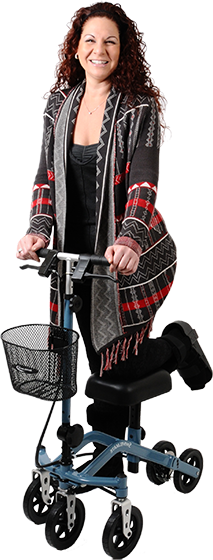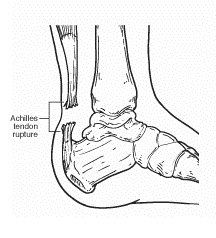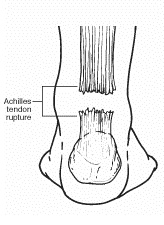-
Non-Weight Bearing Medical Conditions
- < go back to the Learning Center
- A wide variety of injuries and medical conditions require patients to avoid placing any weight on their injured foot or ankle during recovery.
- Knee walkers are medical devices specifically designed for below the knee conditions to allow patients greater mobility around their home or office during the non-weight bearing recovery period. A knee scooter is an invaluable tool which keeps you in an upright position and mobile so you can maintain your lifestyle. We have a variety of knee walker models for sale and rent to meet everyone's specifications.
- Listed below are some common medical conditions and injuries that require a non-weight bearing recovery period.

Swivelmate Knee Walker- The material appearing on this page is for informational use only. It should not be used as a substitute for professional medical advice, diagnosis or treatment. Rent A Knee Walker assumes no responsibility for this content, nor endorses, or guarantees any claim/fact or opinion.
-
Achilles Tendon Rupture
- Content Source: American College of Foot and Ankle Surgeons Read full article here

What is the Achilles Tendon?
A tendon is a band of tissue that connects a muscle to a bone. The Achilles tendon runs down the back of the lower leg and connects the calf muscle to the heel bone. Also called the "heel cord," the Achilles tendon facilitates walking by helping to raise the heel off the ground.What is an Achilles Tendon Rupture?
An Achilles tendon rupture is a complete or partial tear that occurs when the tendon is stretched beyond its capacity. Forceful jumping or pivoting, or sudden accelerations of running, can overstretch the tendon and cause a tear. An injury to the tendon can also result from falling or tripping.Achilles tendon ruptures are most often seen in "weekend warriors" - typically, middle-aged people participating in sports in their spare time. Less commonly, illness or medications, such as steroids or certain antibiotics, may weaken the tendon and contribute to ruptures.Signs and Symptoms
A person with a ruptured Achilles tendon may experience one or more of the following:-
- •
- Sudden pain (which feels like a kick or a stab) in the back of the ankle or calf - often subsiding into a dull ache
- •
- A popping or snapping sensation
- •
- Swelling on the back of the leg between the heel and the calf
- •
- Difficulty walking (especially upstairs or uphill) and difficulty rising up on the toes
-
- These symptoms require prompt medical attention to prevent further damage. Until the patient is able to see a doctor, the "R.I.C.E." method should be used. This involves:
-
- •
- Rest. Stay off the injured foot and ankle, since walking can cause pain or further damage.
- •
- Ice. Apply a bag of ice covered with a thin towel to reduce swelling and pain. Do not put ice directly against the skin.
- •
- Compression. Wrap the foot and ankle in an elastic bandage to prevent further swelling.
- •
- Elevation. Keep the leg elevated to reduce the swelling. It should be even with or slightly above heart level.

Diagnosis
In diagnosing an Achilles tendon rupture, the foot and ankle surgeon will ask questions about how and when the injury occurred and whether the patient has previously injured the tendon or experienced similar symptoms. The surgeon will examine the foot and ankle, feeling for a defect in the tendon that suggests a tear. Range of motion and muscle strength will be evaluated and compared to the uninjured foot and ankle. If the Achilles tendon is ruptured, the patient will have less strength in pushing down (as on a gas pedal) and will have difficulty rising on the toes.- The diagnosis of an Achilles tendon rupture is typically straightforward and can be made through this type of examination. In some cases, however, the surgeon may order an MRI or other advanced imaging tests.
Treatment
Treatment options for an Achilles tendon rupture include surgical and non-surgical approaches. The decision of whether to proceed with surgery or non-surgical treatment is based on the severity of the rupture and the patient's health status and activity level.- Non-Surgical Treatment
Non-surgical treatment, which is generally associated with a higher rate of re-rupture, is selected for minor ruptures, less active patients, and those with medical conditions that prevent them from undergoing surgery. Non-surgical treatment involves use of a cast, walking boot, or brace to restrict motion and allow the torn tendon to heal. - Surgery
Surgery offers important potential benefits. Besides decreasing the likelihood of re-rupturing the Achilles tendon, surgery often increases the patient's push-off strength and improves muscle function and movement of the ankle. - Various surgical techniques are available to repair the rupture. The surgeon will select the procedure best suited to the patient.
- Following surgery, the foot and ankle are initially immobilized in a cast or walking boot. The surgeon will determine when the patient can begin weight bearing
- Complications such as incision-healing difficulties, re-rupture of the tendon, or nerve pain can arise after surgery.
Physical Therapy
Whether an Achilles tendon rupture is treated surgically or non-surgically, physical therapy is an important component of the healing process. Physical therapy involves exercises that strengthen the muscles and improve the range of motion of the foot and ankle.
- The material appearing on this page is for informational use only. It should not be used as a substitute for professional medical advice, diagnosis or treatment. Rent A Knee Walker assumes no responsibility for this content, nor endorses, or guarantees any claim/fact or opinion.
- < go back to the Learning Center
-
- Contact Us
- Call or Email Us - We're Here To Help
- Need help? Call us at 877 520 3708
- Monday - Friday 9:00AM to 6:00PM EST
- Email us:
-
- Current Events:
- Photo Contest
- The Grand Prize of $100 will be awarded to the best knee walker photo. Enter photo contest here
-
-
- Go to mobile website
- Privacy Policy | Terms & Conditions | Trademarks
Affiliate Marketing Disclosure | Site Map - * Monday through Friday, Except holidays and weekends.
- † New orders only, for orders totaling $100 or more, offer not combinable.
- All Rights Reserved ® 2007-2025 / Copyright © 2007-2025 Rent A Knee Walker
-

Looking for knee scooters in the UK? StrideOn is our sister company in the UK, dealing with all things knee scooter related. Rentals, accessories and more.